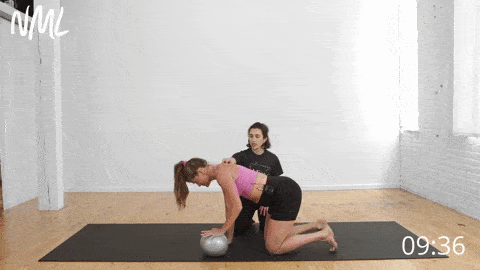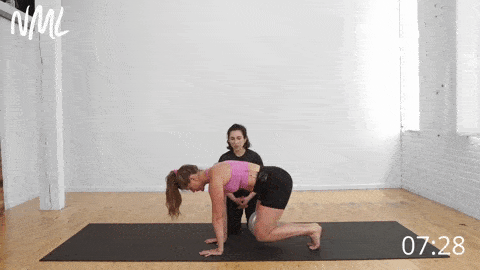 Buy Now →
Buy Now → 

Build deep core and pelvic floor strength with this advanced PILATES AB WORKOUT for diastasis recti. Add this to your workout routine to repair abdominal separation after pregnancy, strengthen the pelvic floor, and build strong abs. This postnatal pilates workout uses a sponge ball to target the deep core, but you can substitute a kids squishy ball or throw pillow if you don’t have one available.
Mastered our Beginner Postpartum Pilates Workout? Then it’s time to scale it up to this ADVANCED version!
We’ve teamed up with my pelvic floor physical therapist (Dr. Sari Abelson PT, DPT) to develop a series of diastasis recti workouts; mixing up the difficulty level, exercises and equipment used to keep things interesting.
Today’s exercise routine increases the intensity and adds in a pilates ball (or throw pillow). This is one of my favorite tools to help make the mind-muscle connection necessary to start repairing diastasis recti or for any beginners looking to build foundational core strength.

Diastasis recti is common in women who have experienced pregnancy. Diastasis recti occurs when the rectus abdominis muscles (six-pack ab muscles) and linea alba (connective tissue) separate as your belly grows during pregnancy. This abdominal separation can range from mild to severe.
Pilates workouts are particularly well-suited for diastasis recti because they are naturally low impact and focus on activating and strengthening all the muscles related to your core. This involves the transverse abdominis, pelvic floor muscles, hips and glutes. This routine is also great for reducing lower back pain and improving posture.
Every postpartum healing experience is different. Talk to your doctor or midwife for medical clearance before returning to exercise after giving birth, especially if you had any complications. I personally started doing the beginner versions of these exercises around 2 weeks postpartum and scaled up to the advanced version a few weeks later. Start where you are and do what you can!

Build strong abs with these 5 ADVANCED pilates exercises you can do at home to heal diastasis recti.
These pilates exercises are specifically designed to heal diastasis recti, strengthen the pelvic floor and glutes, and rebuild your abs after baby. That said, these are great pilates abs exercises for everyone!
Add this diastasis recti workout to your postpartum workout routine as you feel capable, starting with 1-2 times a week and scaling up to 3-4 times a week. I recommend alternating this workout with our advanced bodyweight diastasis recti workout video to avoid workout boredom.
A pilates ball. You can also use a kids squishy ball or a throw pillow if you don’t have a pilates ball available.

Follow along with the guided Advanced Postpartum Ab Exercises on YouTube, led by certified personal trainer and fitness instructor, Lindsey Bomgren.
Your Workout Looks Like This:

Targets: All of your core muscles, including: deep transverse abdomen muscles, rectus abdominis (six pack ab muscles), erector spinae (muscles along the back and spine), oblique muscles, hip abductors and quads.
Your abs are designed to stabilize your body as your arms and legs move away from your body. The bird dog is an excellent exercise in core control and focused breathing.

Targets: Deep transverse abdomen muscles, rectus abdominis (six-pack ab muscles), oblique muscles, shoulders, back, legs, glutes and quads.

Targets: Deep transverse abdominal muscles (TVA), rectus abdominis muscle, lower abs, chest, shoulders and hips.

Modification: Reduce how hard you are pressing against the ball to reduce intensity.
Targets: Obliques (muscles along the sides of your torso), lower abs, outer glutes (gluteus medius), and hip flexors.

Targets: Upper abs, lower abs, obliques, transverse abs, shoulders and back.

Modification: Add an incline to your plank to reduce the intensity.
 Buy Now →
Buy Now →  Buy Now →
Buy Now → 
This post includes affiliate links. I do earn a commission for products purchased using these links (at no additional cost to you). Thank you for supporting Nourish Move Love, making the content you see on this blog possible.